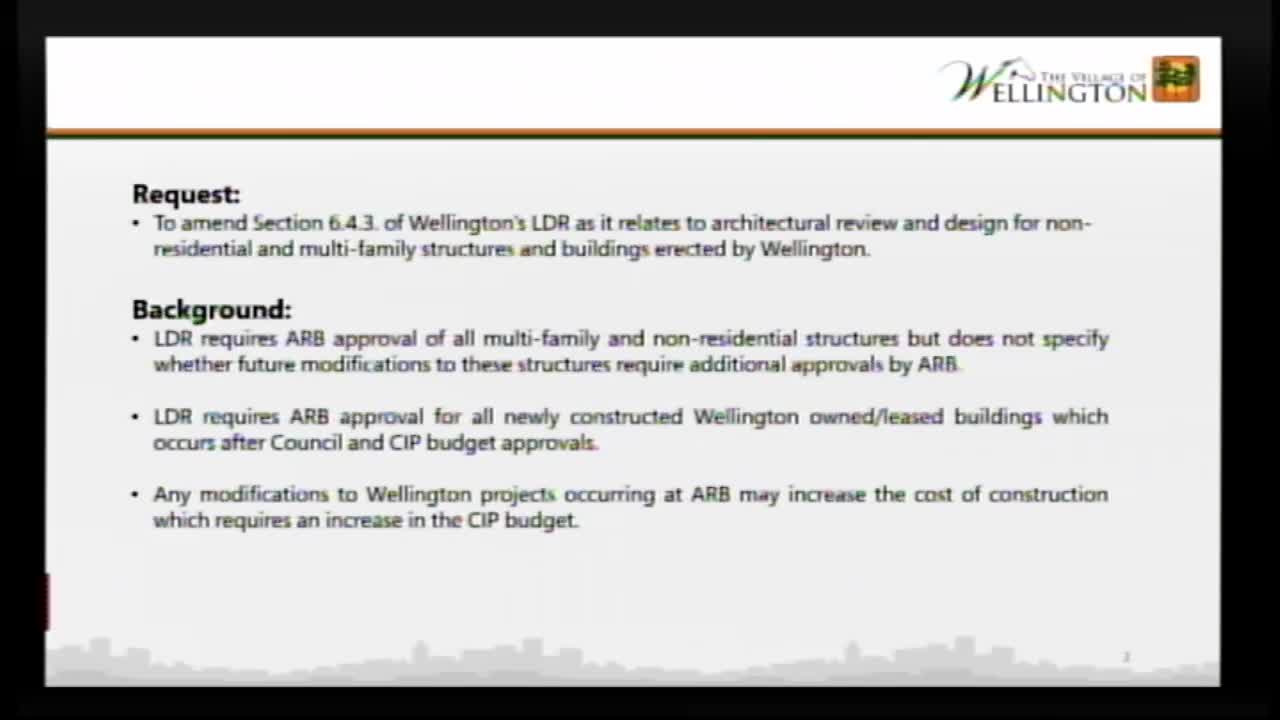Board approves procedural zoning text amendments clarifying ARB and building-height review
October 15, 2025 | Wellington, Palm Beach County, Florida
This article was created by AI summarizing key points discussed. AI makes mistakes, so for full details and context, please refer to the video of the full meeting. Please report any errors so we can fix them. Report an error »

The Planning, Zoning and Adjustment Board voted unanimously Oct. 15 to recommend two staff-initiated zoning text amendments clarifying when the Architectural Review Board (ARB) must review design documents and when council must consider elevations for building-height requests.
Why it matters: The amendments are procedural. They reverse and clarify an existing sequencing issue in the code under which ARB sometimes reviewed final elevations after Village Council had already seen or approved a capital project or a council-directed height increase. The changes require ARB review and recommendation prior to council consideration in specified cases and require the same elevation exhibits to be the basis for both ARB and council review.
What staff presented
Planning staff said the revision to Section 6.4.0.3 (Ordinance 2025-31) ensures ARB approval is required for nonresidential and multifamily projects of a certain scale and that any modifications to approved designs return to ARB. Ordinance 2025-30 revises building-height procedures: projects requesting heights over 35 feet must submit elevation exhibits and obtain ARB review and a council decision in a coordinated sequence so council sees the same imagery ARB considered. Staff said the edit also consolidates certain land-use categories and clarifies landscaping and other criteria tied to increased height allowances.
Board reaction and examples
Board members discussed the change as largely technical and supportive. Staff used the Coach House example to illustrate why council needed to see elevations and have ARB weigh in prior to final approvals. One member asked staff to emphasize the landscaping and palm-count clarifications during the staff’s future council presentation.
Votes
Ordinance 2025-31 (ARB approvals and modifications) passed unanimously. Ordinance 2025-30 (building-height clarifications and minor use-category consolidations) also passed unanimously.
Next steps
Staff will forward both ordinances to Village Council as staff-initiated amendments for formal consideration and adoption.
Ending
Board members described the amendments as housekeeping changes that improve clarity about when design review occurs in the approval sequence and reduce the risk of council approving a concept that ARB later alters visually without council review.
Why it matters: The amendments are procedural. They reverse and clarify an existing sequencing issue in the code under which ARB sometimes reviewed final elevations after Village Council had already seen or approved a capital project or a council-directed height increase. The changes require ARB review and recommendation prior to council consideration in specified cases and require the same elevation exhibits to be the basis for both ARB and council review.
What staff presented
Planning staff said the revision to Section 6.4.0.3 (Ordinance 2025-31) ensures ARB approval is required for nonresidential and multifamily projects of a certain scale and that any modifications to approved designs return to ARB. Ordinance 2025-30 revises building-height procedures: projects requesting heights over 35 feet must submit elevation exhibits and obtain ARB review and a council decision in a coordinated sequence so council sees the same imagery ARB considered. Staff said the edit also consolidates certain land-use categories and clarifies landscaping and other criteria tied to increased height allowances.
Board reaction and examples
Board members discussed the change as largely technical and supportive. Staff used the Coach House example to illustrate why council needed to see elevations and have ARB weigh in prior to final approvals. One member asked staff to emphasize the landscaping and palm-count clarifications during the staff’s future council presentation.
Votes
Ordinance 2025-31 (ARB approvals and modifications) passed unanimously. Ordinance 2025-30 (building-height clarifications and minor use-category consolidations) also passed unanimously.
Next steps
Staff will forward both ordinances to Village Council as staff-initiated amendments for formal consideration and adoption.
Ending
Board members described the amendments as housekeeping changes that improve clarity about when design review occurs in the approval sequence and reduce the risk of council approving a concept that ARB later alters visually without council review.
Don't Miss a Word: See the Full Meeting!
Go beyond summaries. Unlock every video, transcript, and key insight with a Founder Membership.
✓
Get instant access to full meeting videos
✓
Search and clip any phrase from complete transcripts
✓
Receive AI-powered summaries & custom alerts
✓
Enjoy lifetime, unrestricted access to government data
30-day money-back guarantee
